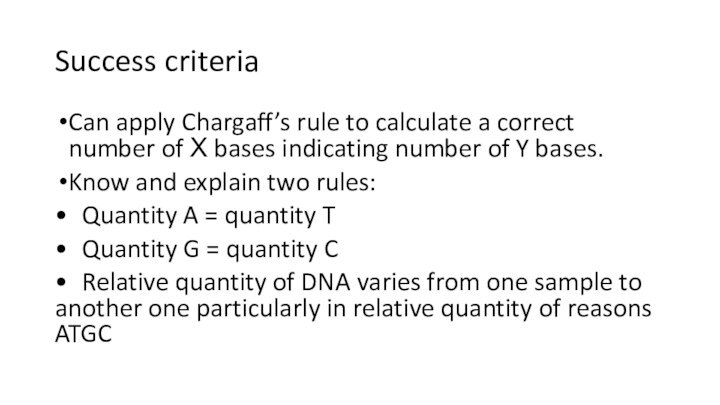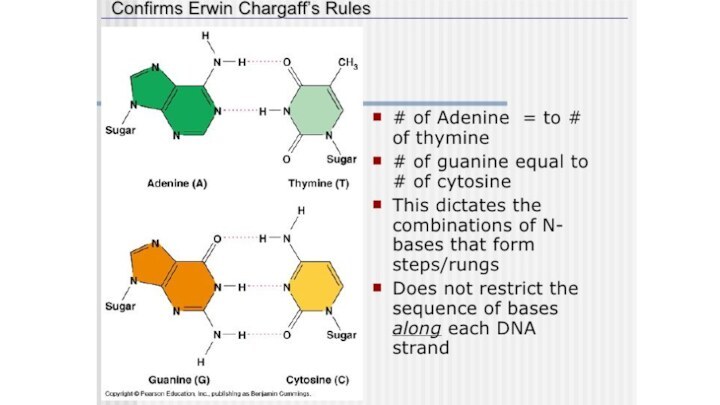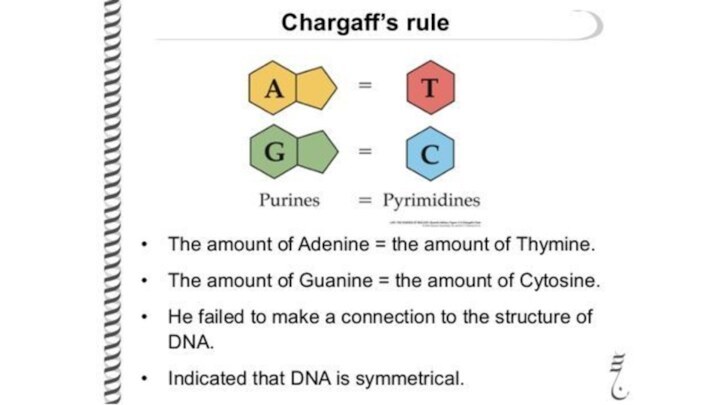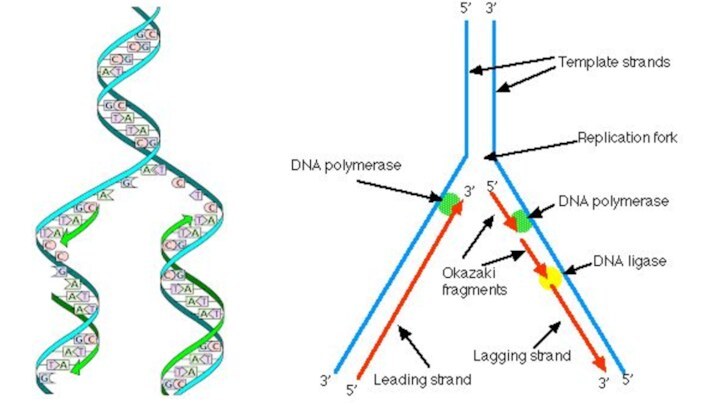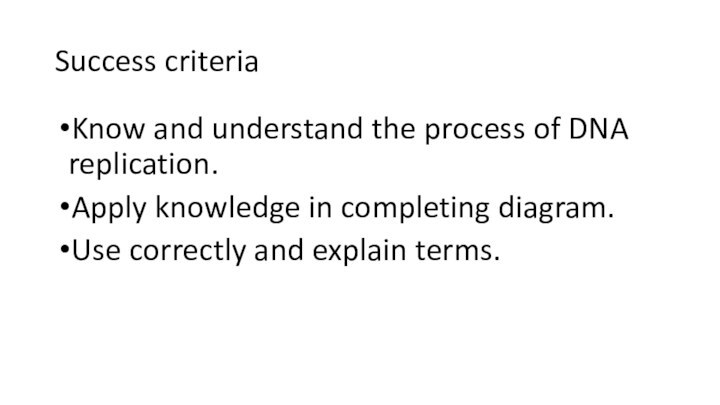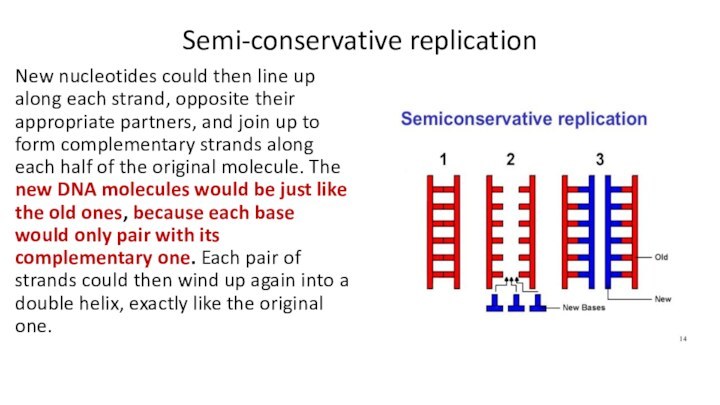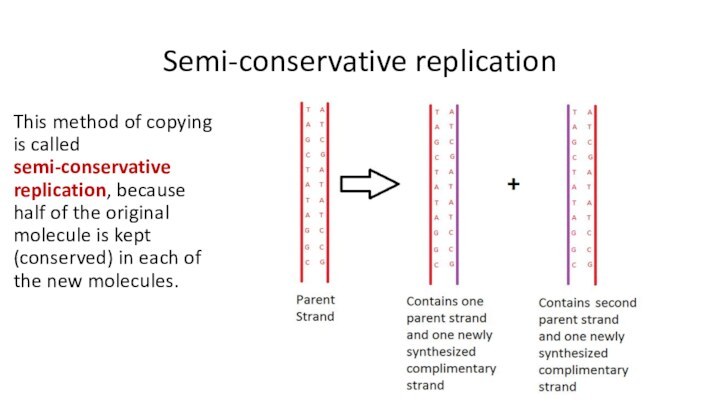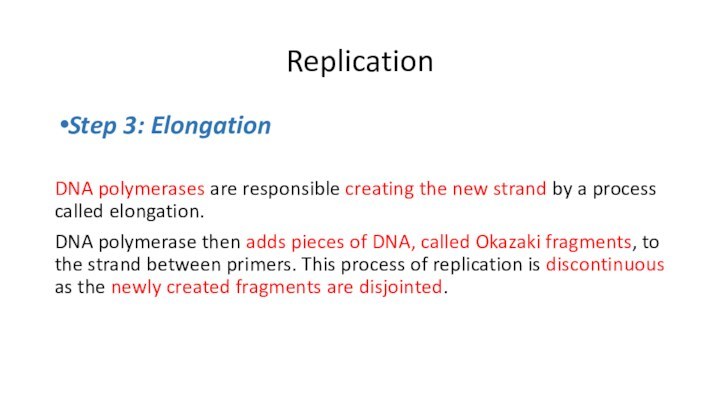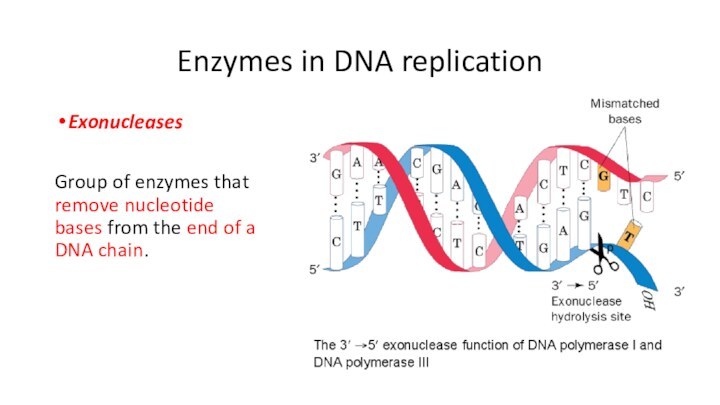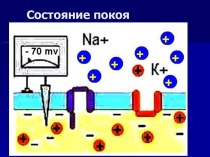Слайд 3
Success criteria
Can apply Chargaff’s rule to calculate
a correct number of Х bases indicating number of
Y bases.
Know and explain two rules:
• Quantity A = quantity T
• Quantity G = quantity C
• Relative quantity of DNA varies from one sample to another one particularly in relative quantity of reasons ATGC
Слайд 10
Learning objectives
11.4.1.11 describe the process of DNA
replication based on Chargaff rules
Слайд 11
Success criteria
Know and understand the process of
DNA replication.
Apply knowledge in completing diagram.
Use correctly
and explain terms.
Слайд 12
Terminology
DNA replication, 5' and 3' end,
Primer
Binding,
Elongation, Termination,
Enzymes: DNA helicase, DNA primase, DNA
polymerases, Topoisomerase or DNA Gyrase, Exonucleases, DNA ligase,
original strands
Слайд 14
DNA replication
As essential feature of DNA is that
it must be able to replicate itself accurately, so
that when a cell divides, the genetic code it carries can be passed on to the daughter cells.
DNA replication copies DNA precisely so that new molecules are produced with exactly the same sequence of bases as the original strands.
Слайд 15
DNA replication
Place: Nucleus
Phase: interphase of the
cell cycle
Слайд 16
Semi-conservative replication
New nucleotides could then line up along
each strand, opposite their appropriate partners, and join up
to form complementary strands along each half of the original molecule. The new DNA molecules would be just like the old ones, because each base would only pair with its complementary one. Each pair of strands could then wind up again into a double helix, exactly like the original one.
Слайд 17
Semi-conservative replication
This method of copying is called semi-conservative
replication, because half of the original molecule is kept
(conserved) in each of the new molecules.
Слайд 18
DNA replication: step by step
First:
The DNA double
helix unwinds and ‘unzips’ as the hydrogen bonds between
the bases break.
Слайд 19
DNA replication: step by step
Second:
In the nucleus, there
are nucleotides to which two extra phosphates have been
added. The extra phosphates activate the nucleotides, enabling them to take part in the following reactions.
Слайд 20
DNA replication: step by step
Third:
Each of the bases
of the activated nucleotides pairs up with its complementary
base on each of the old DNA strands. An enzyme, DNA polymerase, links the sugar and innermost phosphate groups of next-door nucleotides together. The two extra phosphates are broken off and released into the nucleus.
Слайд 21
DNA replication: step by step
Fourth:
DNA polymerase will
only link an incoming nucleotide to the growing new
chain if it is complementary to the base on the old strand. Thus very few mistakes are made, perhaps around one in every 108 base pairs.
Слайд 22
Preparation For Replication
Step 1: Replication Fork Formation
DNA helicase
disrupts the hydrogen bonding between base pairs to separate
the strands into a Y shape known as the replication fork.
Слайд 23
Replication Begins
Step 2: Primer Binding
Once the DNA strands
have been separated, a short piece of RNA called
a primer binds to the 3' end of the strand. The primer always binds as the starting point for replication. Primers are generated by the enzyme DNA primase.
Слайд 24
Replication
Step 3: Elongation
DNA polymerases are responsible creating the
new strand by a process called elongation.
DNA polymerase
then adds pieces of DNA, called Okazaki fragments, to the strand between primers. This process of replication is discontinuous as the newly created fragments are disjointed.
Слайд 25
Replication
Step 4: Termination
Once both the continuous and discontinuous
strands are formed, an enzyme called exonuclease removes all
RNA primers from the original strands.
Once completed, the parent strand and its complementary DNA strand coils into the familiar double helix shape. In the end, replication produces two DNA molecules, each with one strand from the parent molecule and one new strand.
Слайд 26
Enzymes in DNA replication
DNA helicase
It forms the
replication fork by breaking hydrogen bonds between nucleotide pairs
in DNA.
Слайд 27
Enzymes in DNA replication
DNA primase
Primers are short
RNA molecules that act as templates for the starting
point of DNA replication.
Слайд 28
Enzymes in DNA replication
DNA polymerases
Synthesize new DNA
molecules by adding nucleotides to leading and lagging DNA
strands.
Слайд 29
Enzymes in DNA replication
Topoisomerase or DNA Gyrase
Unwinds
and rewinds DNA strands to prevent the DNA from
becoming tangled or supercoiled.
Слайд 30
Enzymes in DNA replication
Exonucleases
Group of enzymes that remove
nucleotide bases from the end of a DNA chain.
Слайд 31
Enzymes in DNA replication
DNA ligase
Joins DNA fragments
together by forming phosphodiester bonds between nucleotides.


